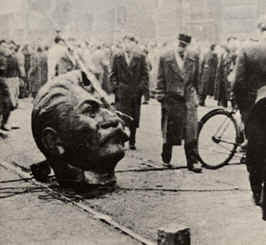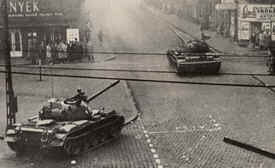Hungary in 1956 seemed to sum up all that the Cold War stood for. The people of Hungary and the rest of Eastern Europe were ruled over with a rod of iron by Communist Russia and anybody who challenged the rule of Stalin and Russia paid the price. The death of Stalin in 1953 did not weaken the grip Moscow had on the people of Eastern Europe and Hungary, by challenging the rule of Moscow, paid such a price in 1956.
From 1945 on the Hungarians were under the control of Moscow. All wealth of whatever nature was taken from Hungary by the Russians who showed their power by putting thousands of Russian troops and hundreds of tanks in Hungary. The Hungarian leader, Rakosi, was put in power by Stalin of Russia. When Stalin died in 1953 all people in Eastern Europe were given some hope that they might be free from Soviet (Russian) rule.
In February 1956, the new Russian leader Khruschev made a bitter attack on the dead Stalin and his policies and in July 1956 in a gesture to the Hungarians, Rakosi was forced to resign. In fact, the Hungarians had expected more but they did not get it. This situation, combined with 1) a bad harvest 2) fuel shortages 3) a cold and wet autumn all created a volatile situation.
On October 23rd 1956, students and workers took to the streets of Budapest (the capital of Hungary ) and issued their Sixteen Points which included personal freedom, more food, the removal of the secret police, the removal of Russian control etc. Poland had already been granted rights in 1956 which had been gained by street protests and displays of rebellion. Hungary followed likewise.

A ruined statue of Stalin in Budapest
Imre Nagy was appointed prime minister and Janos Kadar foreign minister. They were thought to be liberal and in Moscow this was felt to be the best way to keep happy the “hooligans” as the Moscow media referred to the protesters. As a gesture, the Red Army pulled out and Nagy allowed political parties to start again. The most famous man to criticise the Russians was released from prison – Cardinal Mindszenty.
On October 31st, 1956, Nagy broadcast that Hungary would withdraw itself from the Warsaw Pact. This was pushing the Russians too far and Kadar left the government in disgust and established a rival government in eastern Hungary which was supported by Soviet tanks. On November 4th, Soviet tanks went into Budapest to restore order and they acted with immense brutality even killing wounded people. Tanks dragged round bodies through the streets of Budapest as a warning to others who were still protesting.

Russian tanks in Budapest
Hundreds of tanks went into Budapest and probably 30,000 people were killed. To flee the expected Soviet reprisals, probably 200,000 fled to the west leaving all they possessed in Hungary. Nagy was tried and executed and buried in an unmarked grave. By November 14th, order had been restored. Kadar was put in charge. Soviet rule was re-established.
President Eisenhower of USA said “I feel with the Hungarian people.” J F Dulles, American Secretary of State, said “To all those suffering under communist slavery, let us say you can count on us.” But America did nothing more.
So why did Europe and America do nothing except offer moral support and condemn Russia ?
1) Because of the geographic location of Hungary, how could you actually help without resorting to war? Both sides in the Cold War were nuclear powers and the risks were too great. Any economic boycott of the Soviet Union would have been pointless as Russia took what it needed from the countries it occupied.
2) The Suez Crisis, which took place at the same time, was considered far more important and of greater relevance to the west than the suffering of the Hungarians. Hence why Britain, France and America concentrated their resources on this crisis.